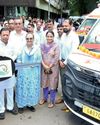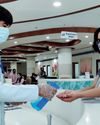
India with around 140 crore people in the country, presently faces a shortage of nursing personnel. The problem has worsened in the last few years. The already stretched-out healthcare sector, also threatens to lead to a decline in the quality of care being provided.
The latest data from the National Health Profile 2022 and a report by FICCI and KPMG indicate that India is facing the worst shortage of nurses in recent years. The country's current capacity of allied healthcare professionals is estimated to be around 57.5 lakhs to 58 lakhs.
According to the World Health Organization (WHO), there should be three nurses per 1,000 population. However, the current figure in India stands at 1.7 nurses per 1,000 population. India currently falls short of at least 43 lakh nurses at present. The shortage is pronounced when compared to developed nations who have up to seven nurses for every 1,000 people.
The nursing deficit in India is more than simply a numbers game. It is a complicated issue influenced by elements such as poor professional and socioeconomic position, gender difficulties, and an uncontrolled private sector. Nurses are routinely underpaid, overworked, and mistreated. These obstacles, along with low pay, an increasing workload, low social standing, and restricted career options, frequently force nurses to seek employment in other countries or quit the profession, resulting in a shortage of trained nurses.
Esta historia es de la edición May 2024 de Healthcare Radius.
Comience su prueba gratuita de Magzter GOLD de 7 días para acceder a miles de historias premium seleccionadas y a más de 9,000 revistas y periódicos.
Ya eres suscriptor ? Conectar
Esta historia es de la edición May 2024 de Healthcare Radius.
Comience su prueba gratuita de Magzter GOLD de 7 días para acceder a miles de historias premium seleccionadas y a más de 9,000 revistas y periódicos.
Ya eres suscriptor? Conectar

KIMSHEALTH launches electrophysiology lab with 3D mapping
'ENSITE X' is the first of its kind in Kerala and the third in India enabling precise identification, mapping, and targeting the abnormal electrical activities in the heart.

Molbio boosts Goa's healthcare system with CSR initiatives
The company has donated four state-of-the-art Advanced Life Support (ALS) ambulances and two hearse vans for National Highway emergencies

USV introduces affordable heart failure medication
This cost-effective option addresses the rising cases of heart failure in India, offering lifesaving care to millions of patients who need it the most.

City Imaging & Clinical Labs to expand services to 50 hospitals
The company is currently associated with 10 hospitals, providing comprehensive lab management services, including 24/7 in-house phlebotomy and lab testing.

Oncare raises $1 million in seed funding, to set up 10 units
Oncare has raised $1 million in a seed funding round led by Huddle Ventures. It plans to deploy the raised capital to expand its operations to 10 new centers.

Nutrabay forays into Ayurvedic supplements market with Shilajit
Nutrabay's aims at gaining market share from the existing ayurveda supplements market with a distinctive product proposition and education about the benefits of Shilajit.

INDIA'S PREPAREDNESS ON HEALTHCARE-ASSOCIATED INFECTIONS: A GROWING FOCUS ON PATIENT SAFETY
The country's diverse healthcare landscape necessitates a flexible and multifaceted approach to infection control that can be adapted to various settings and resource levels.

TRANSFORMING CARDIAC SURGERY: HOW AI IS REVOLUTIONIZING PATIENT CARE AND OUTCOMES
Dr. Swarup Swaraj Pal shared his insights on the current state and future prospects of AI in cardiac procedures.

BEYOND THE LAB: THE CRITICAL ROLE OF LOGISTICS IN INDIA'S PHARMACEUTICAL INDUSTRY
As India continues to expand its role in the global pharmaceutical market, the importance of a robust, reliable, and innovative logistics infrastructure cannot be overstated.

LIFESTYLE DISEASES IN CHILDREN: A WAKE-UP CALL FOR A HEALTHIER GENERATION
In today's fast-paced world, children face an unexpected enemy: lifestyle diseases. Conditions like obesity, Type 2 diabetes, and hypertension are now affecting our youth. What's causing this shift, and how can we combat it?